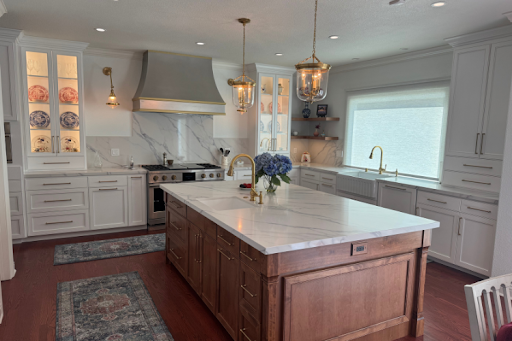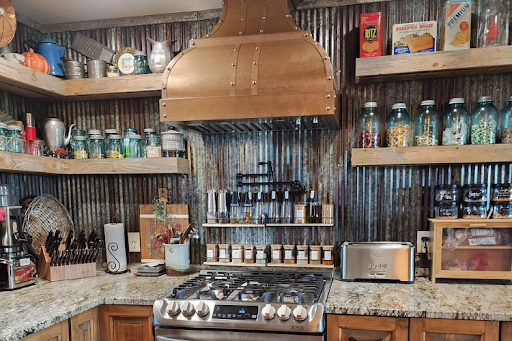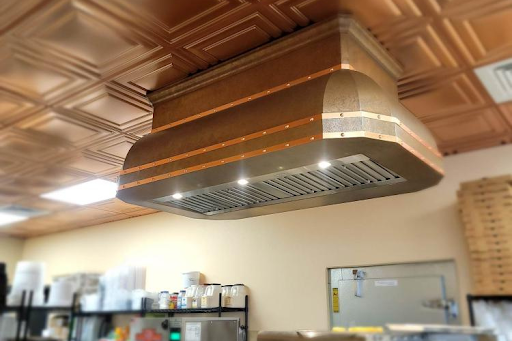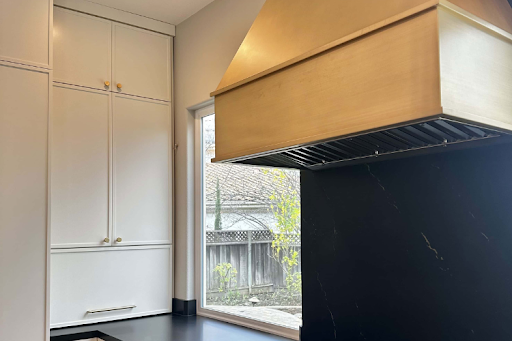The kitchen is the heart of your home. As your trusted partners in metalwork design, we at CopperSmith believe your kitchen must be beautiful and functional. A properly chosen range hood can give it a different look. It can help clear the air and make every meal preparation a great experience.
If you're renovating your space or building a home, you need to understand how to choose the right range hood. This knowledge will help you in creating a clean and healthy cooking environment.
This guide will show you how to select and install the right hood for your kitchen.

What is a Range Hood and Why Do You Need One?
A range hood, which we also call a vent hood or an exhaust hood, is an appliance that's installed above your stove or cooking surface. Its basic purpose is to remove cooking emissions, smoke, steam, odors, and airborne grease particles from your kitchen.
How Range Hoods Improve Kitchen Air Quality
When you cook, your food and the type of fuel you use release steam, hot air, and some harmful particles. A gas range (a stove that burns natural gas or propane) can even release carbon monoxide and nitrogen dioxide. A high-quality ventilation system, such as a range hood, will easily take care of these pollutants. It uses an exhaust fan to remove grease and particles from your home.
This constant removal process stops grease buildup on your cabinets and walls. More importantly, it ensures better air quality in your kitchen.
The Different Types of Range Hoods
There’s a variety of range hood styles in the market today. Manufacturers design these hoods to fit different kitchen layouts.
1. Wall-Mounted Range Hoods

Ventilation experts install wall-mounted hoods directly on the wall. These range hoods need ductwork that runs behind the wall or through the ceiling. They serve as a focal point in your kitchen, offering various styles. CopperSmith designs exquisite wall-mounted hoods that upgrade your kitchen's appearance.
2. Island Range Hoods

If your cooking surface sits on a kitchen island, you need an island range hood. Island hoods are quite different from wall-mounted range hoods. They mount directly to the ceiling and vent straight up. Because they pull in rising smoke from all sides, island hoods require a higher Cubic Feet per Minute (CFM) rating to deliver optimal performance when compared to a wall-mounted unit.
3. Under-Cabinet Range Hoods
Under-cabinet range hoods fit directly under the row of upper cabinets that hang above your stove. They maximize your storage space because they tuck neatly out of the way. You often see these popular, space-saving units in smaller kitchens, or when you remodel and take out an old model or one of those combinations over the range of microwaves. Undercabinet hoods give you flexibility because you can choose either a ducted or a ductless model.
4. Downdraft Hoods
Downdraft hoods offer the simplest, most subtle design. They stay out of sight within the countertop or behind the cooktop when you don't use them. When you activate them, they rise up and pull cooking emissions horizontally across the electric cooktop or gas range surface. However, it's difficult for downdraft hoods to capture high-volume smoke and steam.
5. Ductless Range Hoods
Unlike other types of range hoods, ductless range hoods do not require ductwork to an exterior wall. Instead, they use charcoal filters to clean the air before recirculating it back into the kitchen. Ductless hoods are effective for filtering light cooking odors, but they cannot match the power or complete air removal of a properly ducted system.
How to Choose a Range Hood for Your Kitchen

To choose the right range hood, you must balance your specific cooking needs, kitchen dimensions, and personal style preferences.
What to Consider for Your Cooking Needs
Your cooking style will determine the fan power you need. If you use a standard electric stove for light cooking, like boiling, you don't need much ventilation. However, if you frequently sear, stir-fry, or use a powerful gas range, you generate significantly more smoke and grease.
In that case, you need a hood with high CFM output for the best performance. Think about how often and how intensely you cook before getting a range hood.
How to Match a Range Hood to Your Cooking Surface
Your range hood must be as wide as your cooking surface to get rid of rising smoke and steam. Most range hoods come in standard 30, 36, or 48-inch widths. If you use a large, commercial gas range, choose a hood that gives you 3 to 6 inches of extra width on each side. This ensures the hood pulls in emissions, even those coming from the front burners.
How to Determine the Right Size for Your Range Hood
The height and depth of the hood are equally important as the width. The bottom edge of the vent hood should sit 28 to 36 inches above the cooking surface. For depth, the hood must cover at least half, or two-thirds, of your cooktop. Always check your local building codes and the manufacturer's recommendations.
At CopperSmith, we design premium range hoods that fit most architectural needs.
Important Range Hood Features to Consider
Several factors influence the usability and longevity of your range hood.
Understanding Cubic Feet Per Minute (CFM)
CFM is the most critical number to pay attention to when you choose a range hood. It stands for cubic feet per minute, and it measures exactly how much air the exhaust fan pulls out of your kitchen every minute. A higher CFM rating means that the hood produces more power and clears pollutants faster. Selecting the right CFM ensures your ventilation system keeps the kitchen clean and comfortable.
Calculating the Right CFM for Your Cooking Surface
You can calculate the minimum required CFM based on the type of your cooking surface:
- Electric Cooking Surface: Multiply the linear feet of your cooking surface by 100. (e.g., a 3-foot stove needs 3 times 100 = 300 CFM).
- Gas Range: Add up the total BTU (British Thermal Units) rating of all burners and divide the total by 100. (e.g., 60,000 BTUs/100 = 600 CFM).
Remember, these calculations provide the minimum required CFM. If you cook frequently, you will want powerful range hoods that can deliver more.
Fan Speeds: Choosing the Right Setting for Your Kitchen
The fan speed allows you to adjust the fan power to fit your needs. Most hoods offer at least three speeds: a low setting for gentle simmering, a medium for everyday cooking, and a high setting for searing or heavy smoke. Look for models that operate quietly. A low speed setting shouldn't be more than the noise level of a running refrigerator (around 40 sones). It should let you keep normal conversations while you cook. The noise level shows you a key difference in quality.
Heat Sensors: Enhancing Range Hood Functionality
Heat sensors add an advanced layer of safety and convenience. These devices automatically turn on the exhaust fan or boost the fan speeds when they sense a high level of heat or excess steam rising from the cooking area. This makes sure that the hood delivers optimal performance without manual intervention, which helps greatly when the cooking intensity suddenly increases.
Ducting and Ventilation: Ducted vs. Ductless Range Hoods
The type of ventilation you choose affects the effectiveness of your range hood.
External Venting vs. Recirculating (Ductless) Range Hoods
Ducted hoods use external venting to move all the captured air, grease, and odors completely out of the house, usually through an exterior wall or the roof. This is the most effective ventilation system. Ductless range hoods, in contrast, use charcoal filters to remove some odors and grease before pushing the air back into the kitchen. Ductless systems are easier to install, but they cannot remove heat or moisture.
How Far Can You Vent a Range Hood?
You sacrifice some of the exhaust fan's power when the ductwork gets long or complex. Every curve, section, and even the wall cap slows down the air flow, which reduces the effective CFM the fan moves. Make the duct run as short and straight as possible for best results. If you require a long, intricate run of new ductwork, choose a hood with a higher CFM so it can power through the resistance and perform optimally. Finally, install a backdraft damper to prevent the air outside from forcing its way back inside.
Ductless Range Hoods vs. Ducted Range Hoods: Which One is Right for You?
For most homeowners, a ducted system offers superior air quality and is the preferred choice because it removes all hot air, moisture, and pollutants. However, if you have an apartment or a kitchen where you can't install ductwork because of local building codes, ductless hoods make the best alternative. Just remember that if you pick a ductless system, you must perform regular cleaning and replace the charcoal filters often to maintain performance.
Range Hood Installation: Step by Step
Most homeowners prefer professional installation, but understanding the key steps helps you prepare your kitchen and make sure the work is done correctly.
Step 1: Install the Mounting Bracket for Your Range Hood
First, find the center point above your cooking surface and the required height (usually 28 to 36 inches). Mark the stud locations on the wall and secure the mounting bracket or hardware firmly to the wall studs. This bracket must hold the full weight of the new range hood.
Step 2: Attach the Range Hood to the Mounting Bracket
Lift the hood carefully and set it onto the mounting bracket. If you’re installing one of our wall-mounted hoods, secure it with additional screws through the back panel and into the wall studs. Make sure the hood is level and secure before you proceed.
Step 3: Connecting the Exhaust Fan to the Ductwork
If you have a ducted system, connect the exhaust fan outlet to the ductwork, and seal all joints with metallic tape to prevent air leaks. Next, complete the electrical connections following the manufacturer's instructions. If you’re installing a ductless range hood, put in the charcoal filters at this point. For a detailed guide, see our comprehensive resource on installing a range hood.
Step 4: Testing Your Range Hood Functionality
Once you securely mount and wire the hood, test it. Verify that the built-in lighting works and run the range hood on all fan speeds. Next, turn on the stove and create a little steam or smoke to confirm that the exhaust fan pulls the air effectively into the hood and out through the external venting. If you notice excessive noise or poor suction, contact your professional installation team right away.
CopperSmith: Your Trusted Source for Range Hoods
At CopperSmith, we believe your range hood is a functional utility and a piece of art that defines your kitchen’s aesthetic. We offer a selection of range hoods and custom range hoods designed to be the defining element of your space.
We give you unmatched professional service that guides you through every decision. We often partner with interior designers, architects, and builders worldwide, earning thousands of 5-star reviews for delivering excellent metalwork and design. We handcraft our range hoods to bring your vision to life in both residential and commercial spaces.
The Advantages of CopperSmith's High-Quality Materials
Here at CopperSmith, we forge every hood from premium, sustainable metals. We also provide customization to meet any aesthetic of your choice, whether you want a stunning black range hood, an ornate brass hood, or a custom patina. We offer you the best range hoods for optimal ventilation in your spaces. You can choose from over 80 finishes, textures, and 65 models, ensuring your new range hood fits your cooking area perfectly.
FAQs
How Much CFM for a Range Hood Do I Really Need?
You should aim for a minimum of 100 cubic feet per minute (CFM) per linear foot of your cooking surface (for electric units), or 100 CFM for every 10,000 BTUs of gas range output. If you choose island hoods or you cook frequently, add an extra 200 to 300 CFM for the best performance.
Does Higher CFM Mean Quieter?
No, higher CFM just means more power. The noise level actually depends on the duct size, the motor quality, and the hood's design. The best hoods use high-quality, large blowers and proper ducting to move a large volume of air efficiently without creating noise.
What Do I Consider When Buying a Range Hood?
You must consider the hood type (e.g., wall-mounted hoods or undercabinet hoods), required CFM, ducting requirements, size, and range hood costs. Different factors influence the final decision, but always prioritize ventilation power over aesthetics.
Final Thoughts
You've just learned the essential steps of how to choose a range hood, and now you understand the difference a high-quality ventilation system can have in your home. CopperSmith will provide the final, artisan-crafted touch for your home. Find your touch among our exquisite range hood designs now.
